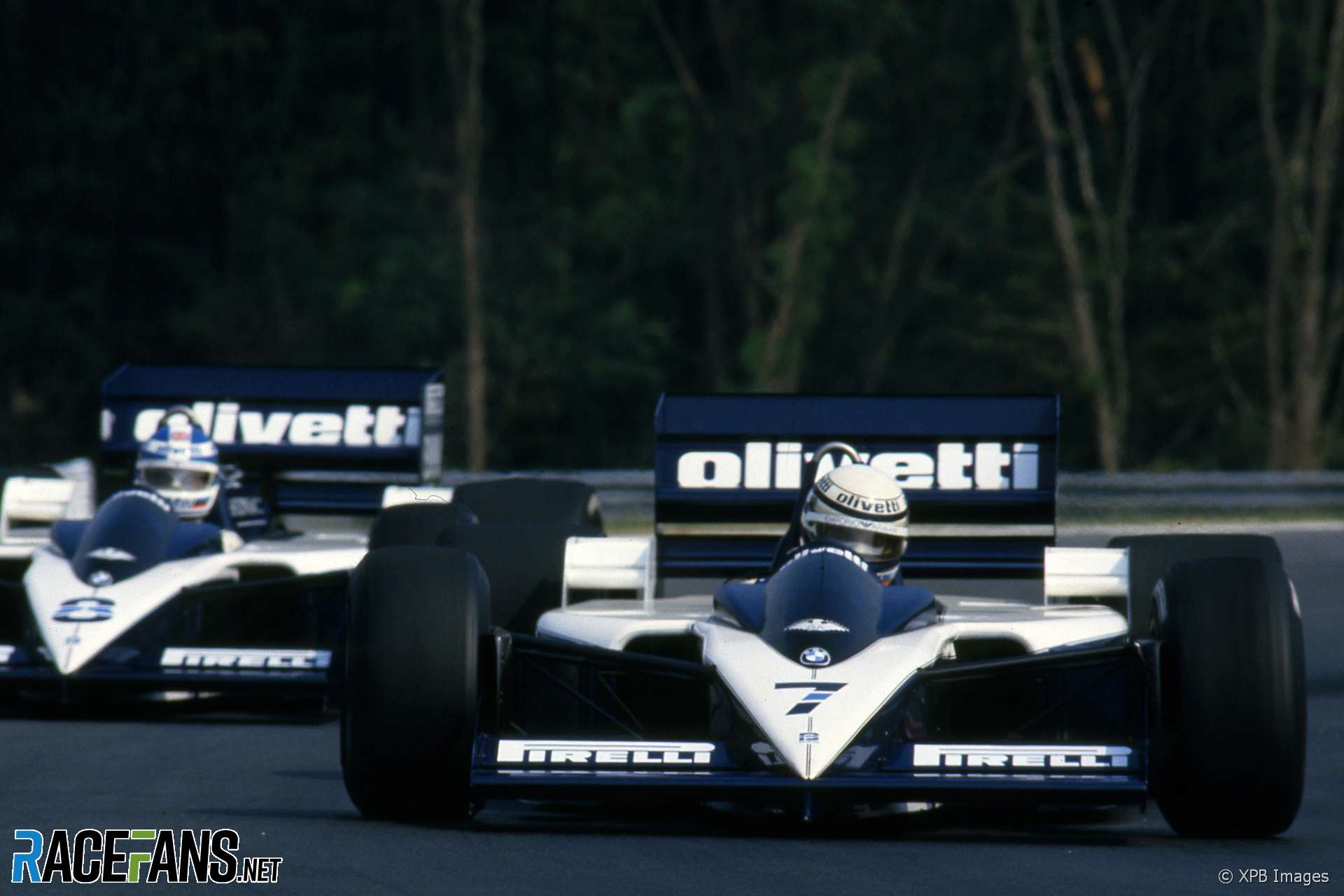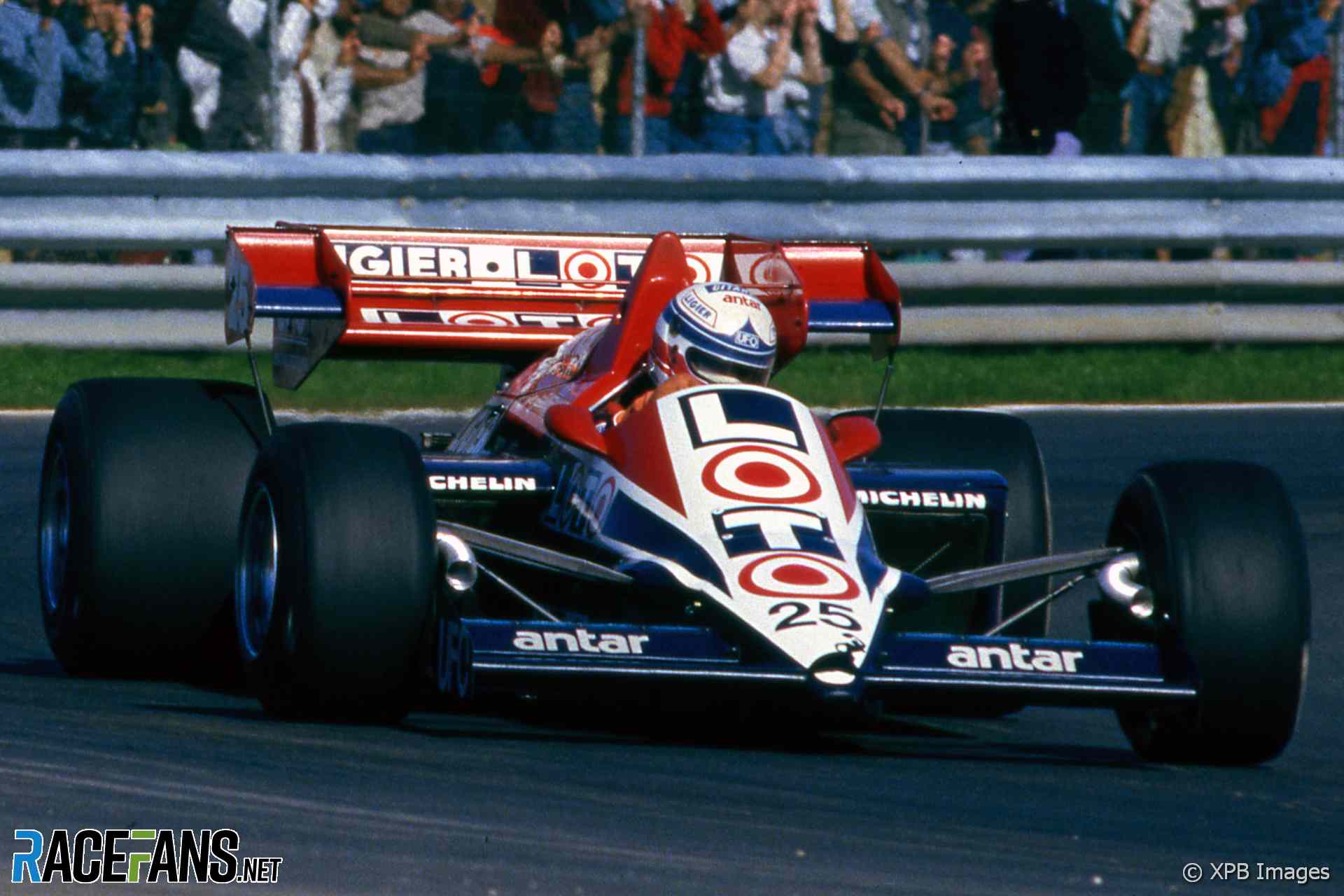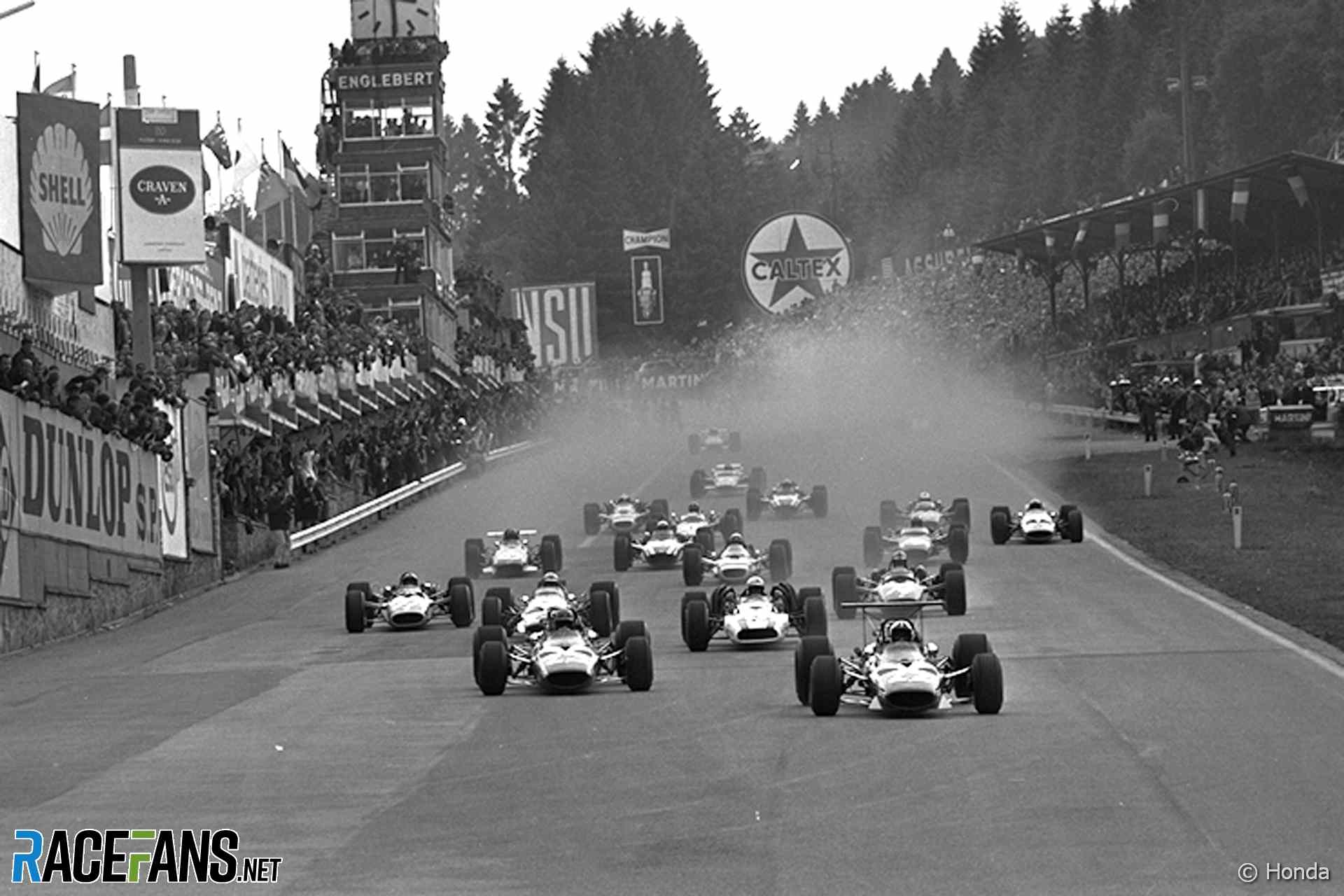Logan Sargeant received an outpouring of sympathy last weekend when he had to give up his Williams so his team mate could drive it.
Alexander Albon crashed the team’s only other FW46 last weekend. Team principal James Vowles reckoned he was their best chance of scoring points – and given their track record it was hard to argue – but even so it was a brutally tough call for Sargeant.
Many sympathised, but very few have been in the same position in Formula 1. Indeed, you have to go back 38 years for the last time it happened, and it’s only happened on five occasions in the last 50 years.
1986: Warwick and Patrese at Brabham

The 1986 season began badly for Brabham, then turned tragic when driver Elio de Angelis was killed in a testing crash at Paul Ricard. Derek Warwick took over his seat alongside Riccardo Patrese, but by round 12 the 1983 champions still had just two points.
The Osterreichring (now Red Bull Ring) offered a strong chance for them to pick up more, as its high speeds and lack of slow corners played to the strengths of Gordon Murray’s low-line BT55 and its explosively powerful BMW turbo. It proved too explosive for Patrese in practice, however, as a huge engine fire put one chassis out of action.
Warwick further depleted the team’s stock of spares when a new Pirelli tyre construction failed at his left-rear, triggering a monumental crash. Nonetheless fourth on the grid for Patrese and 10th for Warwick represented the team’s best qualifying effort of the season to date.
But when a gearbox fault was discovered on Patrese’s car prior to the race, team principal Bernie Ecclestone took the decision to hand him their sole remaining running BT55: Warwick’s. The sacrifice proved to no avail, however, when its engine blew on the second lap.
Advert | Become a RaceFans supporter and
1984: Hesnault and De Cesaris at Ligier

Francois Hesnault’s attempt to make the leap from Formula 3 to Formula 1 didn’t get off to a great start at Ligier in 1984. In his first four starts he suffered two technical failures and collided with Martin Brundle and Jacques Laffite. Round five began unpromisingly when he tangled with Patrese in practice and crashed.
However Hesnault claimed 15th on the grid for his home race at Dijon, which was rather better than his team mate Andrea de Cesaris managed. After Friday’s running his car’s fire extinguisher was found to be empty so his times from first qualifying were deleted. On Saturday it poured with rain and his best effort was 11 seconds too slow.
Only 26 cars could start the race and De Cesaris, Ligier’s experienced number one driver, was 27th. Guy Ligier spotted a solution: Hesnault’s car was withdrawn and de Cesaris took up the final place on the grid.
These days we would say the decision paid off: de Cesaris came in 10th, good for a point now, but not back when only the top six scored. “For a 10th place it would have been better to let Hesnault go out,” Ligier admitted afterwards.
1978: Jarier and Mass at ATS
Much more car-swapping went on in the seventies. In the 1978 Austrian Grand Prix weekend Surtees temporarily pulled Rupert Keegan out of his car mid-weekend, gave Brian Henton a go in it, then swapped them back.Earlier that year in Brazil another driver had Hesnault’s bitter experience of having to surrender his car to the team’ lead driver despite having out-qualified them.
Hesnault’s compatriot Jean-Pierre Jarier had put his ATS 16th, four places ahead of team mate Jochen Mass. But one-time winner Mass, who had joined the team that year from McLaren, had the ‘number one’ designation, and when a leak was found in his fuel tank on Sunday morning he was given Jarier’s car.
The team’s gamble almost paid off: Mass came in seventh, one place outside the points (worth six today). With Mario Andretti struggling home three places ahead, keeping his car in fourth gear as he nursed a transmission problem, ATS nearly had something to celebrate.
1977: Nilsson and Andretti at Lotus

Fire extinguishers play a bigger part in this history than you might expect. But at Buenos Aires in 1977 Andretti’s wasn’t empty – it exploded as he passed the pits at the Buenos Aires circuit. The shocking incident, which occured while Andretti was at full speed, took out the car’s nose and part of its braking system but thankfully not its driver.
As Lotus only had two examples of its new 78 available for the first round of the season, Andretti was given team mate Gunnar Nilsson’s to drive.
From eighth on the grid he was quickly up to fourth place and moved into the podium positions when Niki Lauda began to fall back. However Andretti lost time in a tangle with the lapped Alex Ribeiro, who damaged his front wing, then suffered a wheel bearing problem which put him out with two laps to go.
However most of his rival’s also dropped out – this was the day Jody Scheckter gave Wolf a win on their debut – and Andretti was still classified fifth for two points.
Advert | Become a RaceFans supporter and
1974: Robarts and Belso at Frank Williams Racing
For the only other driver who has relinquished a car for a team mate in the last five decades we return to Williams – or, at least, Frank Williams Racing Cars in its original guise.
The team’s founder embarked on his second season with Arturo Merzario in one car and an array of different drivers turning up in the second. But Merzario missed the Swedish round due to injury, and Richard Robarts took his place alongside Tom Belso.
However during the morning warm-up on race day Belso suffered a suspension failure which sent him down an escape road. With no time to replace it before the start, he was given the team’s other car.
Making his second start in a grand prix, Belso drove the ‘Iso Marlboro’ car to eighth place, his only finish, albeit two places outside of the points. This was Robarts’ fourth and final appearance at a grand prix.
When car swaps were common

Changes in teams’ driver line-ups from race to race or even during weekends was much more common when F1 was less rigidly structured. In the seventies steams brought anything between one and five drivers to some events and broken machinery often led to some missing out.
In addition to the examples above there were another five cases in the seventies and 13 more in the sixties. In the first decade of the world championship the situation was different again, as for much of the time teams were allowed to swap drivers mid-race.
Williams found themselves in the rare situation last weekend because they arrived in Melbourne without a spare car. They originally intended to have one ready for the first round in Bahrain, but the damage Albon did in Australia means they won’t have one for the next race at Suzuka.
They aren’t the first team in recent years to turn up to a race without a spare car. But they are the first in a long time to have to go to the extreme of benching one of their drivers because of it.
Advert | Become a RaceFans supporter and
Become a RaceFans Supporter
RaceFans is run thanks in part to the generous support of its readers. By contributing £1 per month or £12 per year (or the same in whichever currency you use) you can help cover the costs of creating, hosting and developing RaceFans today and in the future.
Become a RaceFans Supporter today and browse the site ad-free. Sign up or find out more via the links below:
F1 history
- How you rated F1’s 12 sprint races so far – and why two outscored the grand prix
- Alonso set to become F1’s oldest driver for more than 50 years
- From ‘Flying Pig’ to Senna’s heroics: The short, incredible history of Toleman
- From farcical to fantastic: Formula 1’s 14 title-deciding Japanese races ranked
- The great go-slows: 10 times F1 drivers threw out the anchor – for different reasons





sumedh
28th March 2024, 8:09
Pirelli. Reliabily unreliable, since 1986
Esploratore (@esploratore1)
28th March 2024, 8:50
I guess since f1 is such a successful sport in terms of competition and stewards, the tyre supplier had to be on the same weavelength.
Esploratore (@esploratore1)
28th March 2024, 8:50
wavelength*
An Sionnach
28th March 2024, 9:02
F1: We want tyres designed to destroy themselves.
Other tyre companies: No
Pirelli: Welcome to my office!
Asd
28th March 2024, 11:04
What used to happened even more often was that both drivers had crashed and teams only had one spare car (so called T-car), so they had to choose which driver to give it to.
I remember at least one case of this in the mid 1990s when there was a major pile-up after the race start, race was red flagged, and between Berger and Alesi (in Ferrari or Benetton) only one of them could jump into the T-car and re-start the race.
Alianora La Canta (@alianora-la-canta)
2nd April 2024, 20:47
This is very true. Four drivers could not have taken the restart of the 1998 Belgian Grand Prix for this reason – both drivers’ cars were too severely damaged in the original 13-car pile-up and only one could use the spare car. Stewart had the easiest decision as Barrichello had injured his arm, but Olivier Panis, Mika Salo and Ricardo Rosset were denied the possibility due to their team-mates Pedro Diniz, Jarno Trulli and Toransuke Takagi being granted the spare. In all three cases, the driver granted the spare had outqualified the one who lost out. Diniz and Trulli scored 3 points between them for 5th and 6th, Takagi spun on lap 10 of a very wet race.
Tristan
28th March 2024, 11:52
That you have to go so far back speaks volumes of how bad this was for Williams, and Sargeant. Not one of these teams ever valued one of their drivers so poorly that they chose to sit a driver just because the other driver crashed their own car.
Wrong for Williams to demand it really. Sure they want to maximise points but wrong to deny Sargeant the chance to earn them when Albon totalled his own car, and they’re fully responsible for the lack of spare.
If you can’t trust him to achieve your goals, why is he your driver?
ferrox glideh (@ferrox-glideh)
28th March 2024, 12:16
I am guessing that Sargeant brings more money than talent to the team, and that is why he is their driver. Unfortunately, he apparently doesn’t bring enough money for them to have a spare chassis. Williams went with their best driver in search for points (future money), and although it is a bad look for Williams, the finances must be bad enough to warrant their decision. I imagine that Williams wants to trust Sargeant to achieve their goals, but he hasn’t really done anything on track to warrant that. Hopefully they will have a better driver whom they can trust in such a way next year.
Alianora La Canta (@alianora-la-canta)
2nd April 2024, 20:48
@ferrox-glideh I think this issue began because Sargeant brought money and not, alas, time.
Asd
28th March 2024, 12:27
“That you have to go so far back speaks volumes of how bad this was for Williams, and Sargeant. Not one of these teams ever valued one of their drivers so poorly that they chose to sit a driver…”
I’m not entirely sure what your point is here, but the fact is that it’s been a super rare occurrence that a team was left with only 1 car for the race. Have a car destroyed after quali is a normal thing that happens each season at least once. Not having a spare car in that scenario is what’s rare. There have been very few instances of teams having to make such a decision.
Tristan
28th March 2024, 13:13
Yep, and that’s entirely Williams fault. Even Haas never had to sit their drivers in the worst years. Not to mention the 2012 three.
It’s just a really bad look for Williams. Given their Andretti-entry protest the hypocrisy is egregious.
It’s hard to excuse them when the rarity of the circumstance is precisely due to the teams usually seeing the value of having both their cars in the race.
Esploratore (@esploratore1)
28th March 2024, 21:45
Yes, absolutely, it’s shameful that they don’t let andretti in given the state of some teams.
bernasaurus (@bernasaurus)
29th March 2024, 6:12
It’s happened not that long ago and in Australia when Sauber didn’t have a chassis for Giedo Van der Garde. Perhaps more embarrassing than Williams, but at least they had two cars in the race.
AlanD
28th March 2024, 22:28
I think I remember a case many years ago when Schumacher decided his team mates car was working better than his own so he commandeered it. But that would be a car swap rather than the other driver having to stand down.
mog
29th March 2024, 6:06
That Sargeant was benched is a vote of no-confidence by the team. Seemingly, the argument for this was Albon is better and points will be hard to come by due to the top five occupying the 10 scoring spots by default every weekend.
I wonder, however, if the decision also demonstrated a vote of no confidence in the car and even the teams engineering. With 21 races remaining, William’s did not think they can develop their car to a position where it will be in the immediate vicinity of points if one of the top teams falters on one of the 21 . This is implied in their reasoning, which seems desperate.
As Tristan says above, it was wrong for Williams to demand it really.
mog
29th March 2024, 6:07
*21 races remaining